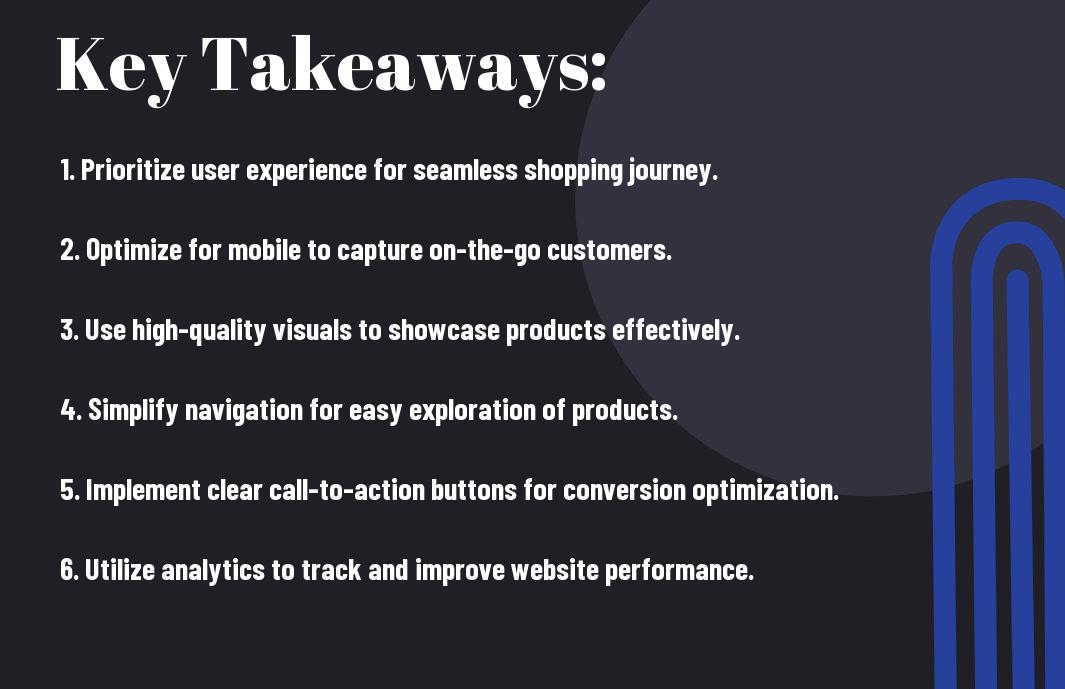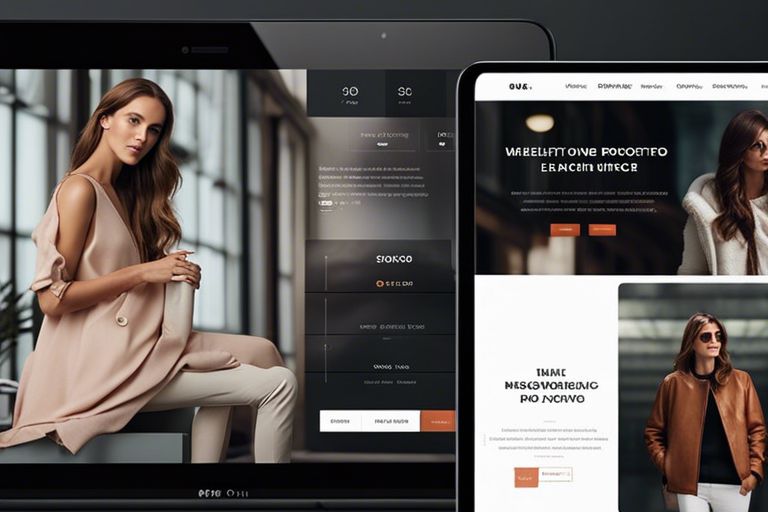Maximizing the potential of your e-commerce website requires a strategic approach to design. Your website’s layout, user interface, and overall aesthetic can have a significant impact on your conversion rates, customer retention, and overall success. In this blog post, we will explore how you can leverage website design to drastically improve your e-commerce results. From optimizing your product pages to creating a seamless checkout process, we will cover the essential elements to focus on when it comes to website design for e-commerce. By implementing these best practices, you can position your online store for maximum success and growth in the competitive e-commerce landscape.
Key Takeaways:
- Responsive Design: Ensure your website is optimized for mobile and tablet users to capture a wider audience and improve user experience.
- User-Friendly Navigation: Simplify the search and purchase process for customers by using clear navigation and streamlined checkout procedures.
- SEO-Optimized Content: Enhance your website’s visibility and reach by incorporating relevant keywords and high-quality content to attract organic traffic.
- Visual Appeal: Utilize eye-catching and engaging visuals to captivate potential customers and create a memorable brand experience.
- Conversion-Oriented Design: Implement strategic calls-to-action, product displays, and checkout prompts to guide visitors towards making a purchase.

Enhancing User Experience
Obviously, when it comes to leveraging e-commerce and digital sales channels, one of the most crucial aspects is enhancing the user experience on your website. It is essential to create a seamless and enjoyable journey for your visitors, making it easy for them to find what they are looking for and complete their purchase.
Simplifying Navigation
One of the key elements of enhancing user experience is simplifying navigation. When visitors come to your website, they should be able to easily find what they are looking for without having to click through multiple pages. Your navigation menu should be clear and intuitive, allowing users to quickly locate the products or information they need. By simplifying navigation, you can reduce frustration and make it more likely for visitors to make a purchase.
Accelerating Page Load Speeds
Another crucial factor in enhancing user experience is accelerating page load speeds. Slow-loading pages can be a major deterrent for potential customers and can lead to high bounce rates. By optimizing your website to load quickly, you can improve user satisfaction and make it more likely for visitors to browse through your products and complete a purchase.
Mobile Responsiveness and Cross-Device Compatibility
With the increasing use of mobile devices for online shopping, it’s important to ensure that your website is fully responsive and compatible across all devices. Your website should provide a seamless experience for users, regardless of whether they are accessing it from a desktop, smartphone, or tablet. By prioritizing mobile responsiveness and cross-device compatibility, you can capture a wider audience and maximize your e-commerce results.
Maximizing Conversion Rates
Now that you have a visually appealing and user-friendly website design, it is time to focus on maximizing conversion rates. Enhancing your e-commerce results means turning website visitors into paying customers. You can achieve this by strategically placing call-to-action elements and streamlining the checkout process.
Effective Use of Call-to-Action Elements
When it comes to converting website visitors into customers, the strategic use of call-to-action (CTA) elements is crucial. These elements guide your visitors through the purchasing process and encourage them to take desired actions, such as making a purchase, signing up for a newsletter, or requesting more information. It is essential to place CTAs prominently on your website, using contrasting colors and compelling copy to grab your visitors’ attention. Make sure your CTAs are clear, concise, and persuasive, prompting visitors to take the next step in the buying process without any confusion or hesitation.
Streamlining the Checkout Process
The checkout process can make or break a sale, so it is essential to streamline it for a seamless and hassle-free experience for your customers. Lengthy, complicated, or confusing checkout processes can lead to cart abandonment, resulting in lost sales. You can streamline the checkout process by implementing a guest checkout option, reducing the number of form fields, offering multiple payment options, and providing transparent shipping costs and delivery times. Additionally, removing distractions such as navigation menus and sidebars on the checkout page can help keep the focus on completing the purchase. By streamlining the checkout process, you can reduce friction and make it as easy as possible for your customers to complete their purchases, ultimately boosting your e-commerce results.
Incorporating effective use of call-to-action elements and streamlining the checkout process are crucial steps in maximizing conversion rates on your e-commerce website. By focusing on these aspects, you can ensure that you are guiding your visitors through a seamless buying journey and increasing the likelihood of turning them into satisfied customers. Utilize these strategies to optimize your website for maximum conversions and to drive positive results for your e-commerce business.
Incorporating Visual Elements
Your e-commerce website’s visual elements play a crucial role in attracting and engaging customers. Whether it’s the product images or the overall design, visual appeal can make or break a customer’s decision to make a purchase. Here’s how you can leverage visual elements to boost your e-commerce results.
Utilizing High-Quality Images and Videos
When it comes to showcasing your products, high-quality images and videos are non-negotiable. You want to provide your customers with a clear and detailed view of what they are purchasing, as this can instill confidence and lead to higher conversion rates. Consider investing in professional photography/videography to ensure that your products are presented in the best possible light. Interactive product videos, in particular, can dramatically improve the customer experience and their understanding of the product.
Balancing Aesthetics with Functionality
While visual appeal is essential, it’s equally important to strike a balance between aesthetics and functionality. Your website design should be visually engaging, but it should also facilitate easy navigation and quick access to product information. Implement a user-friendly interface that allows customers to seamlessly browse through your products, add items to their cart, and complete the purchase process without any confusion or frustration. Remember, a visually appealing website is great, but a website that is both visually appealing and functional is what will ultimately drive conversions.
Building Brand Identity
Keep in mind that your website design serves as the digital storefront for your e-commerce business, and it’s crucial to reflect your brand identity through it. Your brand identity includes your company’s values, mission, and promises to your customers. The way your website looks and feels should align with these elements to create a cohesive and memorable brand experience for your visitors.
Aligning Design with Brand Messaging
When designing your e-commerce website, it’s essential to ensure that the visual elements and messaging align with your brand’s identity. Your website should reflect your brand’s personality, values, and the promises you make to your customers. This means using consistent brand colors, fonts, and visual elements that are in line with your overall brand image. By doing so, you build a stronger emotional connection with your audience, making it more likely for them to remember and engage with your brand.
Creating a Consistent User Interface
When it comes to e-commerce, a consistent user interface is key to ensuring a smooth and seamless shopping experience for your customers. Your website’s design should consistently reflect key elements such as navigation menus, search bars, and buttons throughout the site. This consistency not only simplifies the browsing and purchasing process for your customers but also reinforces your brand’s identity and professionalism.

Utilizing Analytics and Feedback
Not sure how to effectively leverage website design to boost your e-commerce results? Utilizing analytics and gathering feedback is crucial to understanding your website performance. By analyzing data and customer feedback, you can make informed decisions to optimize your website for conversions. For more tips on boosting e-commerce website sales, check out 7 Bullet-Proof Ideas to Boost Your Ecommerce Website Sales.
Monitoring User Behavior
When it comes to leveraging website design for e-commerce success, monitoring user behavior is essential. You can track how visitors interact with your website, identify the most popular products, and understand where users tend to drop off in the conversion process. By examining this data, you can make data-driven decisions to optimize your website’s user experience and ultimately boost your e-commerce results. Understanding user behavior is key to refining your website design and increasing conversions.
Testing and Iterating Design Elements
Testing and iterating design elements on your e-commerce website is a critical part of leveraging website design to boost your results. By running A/B tests and experimenting with different design elements, you can identify what resonates best with your target audience and drives the most conversions. This iterative approach allows you to continuously refine and optimize your website design, ensuring that it effectively supports your e-commerce goals. Regularly testing and iterating design elements can lead to significant improvements in your website’s performance and ultimately, your e-commerce results.
The Power of Leveraging Website Design for E-Commerce Success
The key to boosting your e-commerce results lies in strategically leveraging your website design. By creating a user-friendly and visually appealing website, you can enhance the shopping experience for your customers and ultimately increase sales. Ensuring that your website is mobile-responsive, optimizing load times, and incorporating intuitive navigation are just a few of the design elements that can make a significant impact on your e-commerce performance. Additionally, implementing clear calls-to-action, high-quality product images, and a seamless checkout process can further improve customer engagement and conversion rates. By prioritizing website design as an integral part of your e-commerce strategy, you can effectively drive growth and success for your online business.
FAQ
Q: How can website design be leveraged to boost e-commerce results?
A: Website design can be leveraged to boost e-commerce results by ensuring a user-friendly interface, intuitive navigation, mobile responsiveness, and visually appealing product displays. These elements help create a positive user experience, leading to increased engagement and conversions.
Q: What role does mobile responsiveness play in e-commerce website design?
A: Mobile responsiveness is crucial in e-commerce website design as a significant portion of online traffic comes from mobile devices. Ensuring that the website is optimized for mobile devices allows for a seamless browsing and purchasing experience for mobile users, ultimately increasing sales and customer satisfaction.
Q: How can a visually appealing product display impact e-commerce results?
A: A visually appealing product display can significantly impact e-commerce results by attracting the attention of potential customers, increasing product visibility, and ultimately leading to higher conversion rates. High-quality images, clear product descriptions, and strategic placement can all contribute to a compelling product display.
Q: What are the key elements of a user-friendly e-commerce website design?
A: Key elements of a user-friendly e-commerce website design include streamlined navigation, intuitive search functionality, clear product categorization, easy checkout process, and prominent calls-to-action. These elements are essential for guiding users through the purchasing journey and minimizing potential barriers to conversion.
Q: How can website design be optimized for search engines to improve e-commerce results?
A: Optimizing website design for search engines involves implementing relevant keywords, meta tags, and structured data to improve the website’s visibility in search engine results. Additionally, ensuring fast loading times, secure connections, and mobile optimization contributes to higher search engine rankings, ultimately driving more organic traffic and potential sales.
